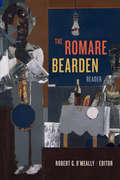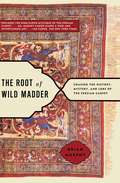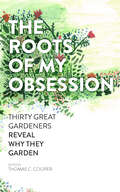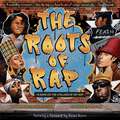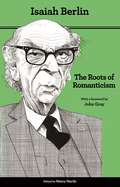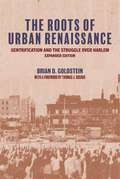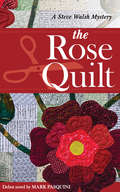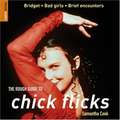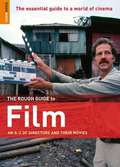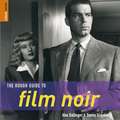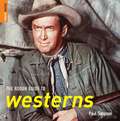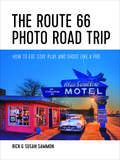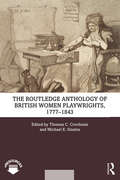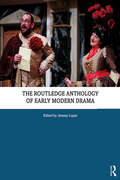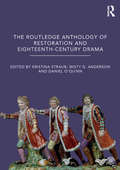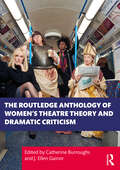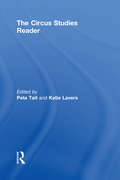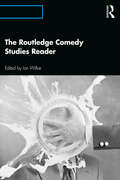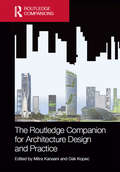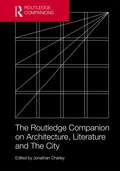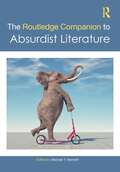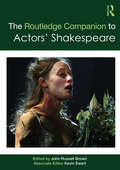- Table View
- List View
The Romare Bearden Reader
by Robert G. O'MeallyThe Romare Bearden Reader brings together a collection of new essays and canonical writings by novelists, poets, historians, critics, and playwrights. The contributors, who include Toni Morrison, Ralph Ellison, August Wilson, Farah Jasmine Griffin, and Kobena Mercer, contextualize Bearden's life and career within the history of modern art, examine the influence of jazz and literature on his work, trace his impact on twentieth-century African American culture, and outline his art's political dimensions. Others focus on specific pieces, such as A Black Odyssey, or the ways in which Bearden used collage to understand African American identity. The Reader also includes Bearden's most important writings, which grant readers insight into his aesthetic values and practices and share his desire to tell what it means to be black in America. Put simply, The Romare Bearden Reader is an indispensable volume on one of the giants of twentieth-century American art. Contributors. Elizabeth Alexander, Romare Bearden, Mary Lee Corlett, Rachel DeLue, David C. Driskell, Brent Hayes Edwards, Ralph Ellison, Henri Ghent, Farah Jasmine Griffin, Harry Henderson, Kobena Mercer, Toni Morrison, Albert Murray, Robert G. O’Meally, Richard Powell, Richard Price, Sally Price, Myron Schwartzman, Robert Burns Stepto, Calvin Tomkins, John Edgar Wideman, August Wilson
The Root of Wild Madder
by Brian MurphyWisdom of a Turkmen proverb. The Root of Wild Madder opens with an invitation that flows from the same ancient inspiration. "A carpet is poetry itself," an Iranian carpet merchant declares to author Brian Murphy. "You just have to learn to read them." So begins a journey. It follows Persian carpets from the remote villages of Afghanistan and Iran where they are woven -- often by young girls -- and on to the bazaars where they are traded, to the Sufis and mystic poets who find grace and magic in their timeless designs, and, finally and unexpectedly, to a carpet showroom in New York. Told in exquisite prose befitting one of the world's loveliest art forms, The Root of Wild Madder eloquently chronicles how carpets embody humanity's endless striving for unattainable perfection. Here are stories of the weavers and their dreams, the "mules" who move the carpets from place to place, the tradesmen who sell them in the bazaars, and the refugee compelled to trade a carpet he believes contains the soul of his grandmother -- because his family must eat. The madder plant has fed the carpets' red brilliance since the earliest weavings. But the power of its palette, like the dyers' traditions, threatens to pass from memory. It would be a profound loss. It's part of a world as rich as any sublime carpet: steeped in spirituality, culture, allegory, and, above all, mystery. Nearly all the carpet masterworks are anonymous art for the ages, and Murphy seeks out their glorious hidden narratives. As he observes, "Every carpet carries its own distinctive voice. Suddenly I wanted to hear them."
The Roots of My Obsession: Thirty Great Gardeners Reveal Why They Garden
by Thomas C. CooperWhy do you garden? For fun? Work? Food? The reasons to garden are as unique as the gardener.The Roots of My Obsession features thirty essays from the most vital voices in gardening, exploring the myriad motives and impulses that cause a person to become a gardener. For some, it’s the quest to achieve a personal vision of ultimate beauty; for others, it’s a mission to heal the earth, or to grow a perfect peach. The essays are as distinct as their authors, and yet each one is direct, engaging, and from the heart. For Doug Tallamy, a love of plants is rooted first in a love of animals: “animals with two legs (birds), four legs (box turtles, salamanders, and foxes), six legs (butterflies and beetles), eight legs (spiders), dozens of legs (centipedes), hundreds of legs (millipedes), and even animals with no legs (snakes and pollywogs).” For Rosalind Creasy, it’s “not the plant itself; it’s how you use it in the garden.” And for Sydney Eddison, the reason has changed throughout the years. Now, she “gardens for the moment.” As you read, you may find yourself nodding your head in agreement, or gasping in disbelief. What you’re sure to encounter is some of the best writing about the gardener’s soul ever to appear. For anyone who cherishes the miracle of bringing forth life from the soil, The Roots of My Obsession is essential inspiration.
The Roots of Rap: 16 Bars on the 4 Pillars of Hip-Hop
by Carole Boston Weatherford"Carole Boston Weatherford, once again, delivers a resounding testament and reminder, that hip-hop is a flavorful slice of a larger cultural cake. And to be hip-hop-to truly be it-we must remember that we are also funk, jazz, soul, folktale, and poetry. We must remember that . . . we are who we are!" -Jason Reynolds, New York Times best-selling author"Starting with its attention-getting cover, this picture book does an excellent job of capturing the essence of rap . . . This tribute to hip hop culture will appeal to a wide audience, and practically demands multiple readings." ―Booklist, STARRED REVIEW"No way around it, this book is supa-dupa fly, with lush illustrations anchored in signature hip-hop iconography for the future of the global hip-hop nation." ―Kirkus Reviews, STARRED REVIEW"With short, rhyming lines and dramatic portraits of performers, the creative team behind How Sweet the Sound: The Story of Amazing Grace offers a dynamic introduction to hip-hop. . . . This artful introduction to one of the most influential cultural movements of the 20th century pulses with the energy and rhythm of its subject." ―Publishers Weekly, STARRED REVIEWExplore the roots of rap in this stunning, rhyming, triple-timing book, now available as a board book!A generation voicing stories, hopes, and fearsfounds a hip-hop nation.Say holler if you hear.The roots of rap and the history of hip-hop have origins that precede DJ Kool Herc and Grandmaster Flash. Kids will learn about how it evolved from folktales, spirituals, and poetry, to the showmanship of James Brown, to the culture of graffiti art and break dancing that formed around the art form and gave birth to the musical artists we know today. Written in lyrical rhythm by award-winning author and poet Carole Boston Weatherford and complete with flowing, vibrant illustrations by Corettta Scott King Award winner, Frank Morrison, this book beautifully illustrates how hip-hop is a language spoken the whole world 'round, and it features a foreword by Swizz Beatz, a Grammy Award-winning American hip-hop rapper, DJ, and record producer.
The Roots of Romanticism: Second Edition (The A. W. Mellon Lectures in the Fine Arts #45)
by Isaiah BerlinA brilliant brief account of romanticism and its influence from one of the most important philosophers and intellectual historians of the twentieth centuryIn The Roots of Romanticism, one of the twentieth century's most influential philosophers dissects and assesses a movement that changed the course of history. Brilliant, fresh, immediate, and eloquent, these celebrated Mellon Lectures are a bravura intellectual performance. Isaiah Berlin surveys the many attempts to define romanticism, distills its essence, traces its developments from its first stirrings to its apotheosis, and shows how it still permeates our outlook. He ranges over a cast of some of the greatest thinkers and artists of the eighteenth and nineteenth centuries, including Kant, Rousseau, Diderot, Schiller, the Schlegels, Novalis, Goethe, Blake, Byron, and Beethoven. The ideas and attitudes of these and other figures, Berlin argues, helped to shape twentieth-century nationalism, existentialism, democracy, totalitarianism, and our ideas about heroic individuals, self-fulfillment, and the exalted place of art.This new edition, illustrated for the first time, also features a new foreword by philosopher John Gray, in which he discusses Berlin's belief that the influence of romanticism has been unpredictable and contradictory in the extreme, fuelling anti-liberal political movements but also reinvigorating liberalism; a revised text; and a new appendix that includes some of Berlin's correspondence about the lectures and the reactions to them.
The Roots of Urban Renaissance
by Brian D. GoldsteinIn charting the growth of gleaming shopping centers and refurbished brownstones in Harlem, Brian Goldstein shows that gentrification was not imposed on an unwitting community by opportunistic developers or outsiders. It grew from the neighborhood’s grassroots, producing a legacy that benefited some longtime residents and threatened others.
The Roots of Urban Renaissance: Gentrification and the Struggle over Harlem, Expanded Edition
by Brian D. GoldsteinAn acclaimed history of Harlem’s journey from urban crisis to urban renaissanceWith its gleaming shopping centers and refurbished row houses, today’s Harlem bears little resemblance to the neighborhood of the midcentury urban crisis. Brian Goldstein traces Harlem’s Second Renaissance to a surprising source: the radical social movements of the 1960s that resisted city officials and fought to give Harlemites control of their own destiny. Young Harlem activists, inspired by the civil rights movement, envisioned a Harlem built by and for its low-income, predominantly African American population. In the succeeding decades, however, the community-based organizations they founded came to pursue a very different goal: a neighborhood with national retailers and increasingly affluent residents. The Roots of Urban Renaissance demonstrates that gentrification was not imposed on an unwitting community by unscrupulous developers or opportunistic outsiders. Rather, it grew from the neighborhood’s grassroots, producing a legacy that benefited some longtime residents and threatened others.
The Rose Quilt: A Steve Walsh Mystery
by Mark PasquiniIn the Roaring Twenties, a detective must sew up a case of quilting gone wrong—first in the cozy mystery series. It is the 1920s, in the world of quilting circles. Alice Chandler, a wealthy woman and prominent local quilter, is murdered with a pair of quilting shears during the preparations for a local flower show, leaving a dying clue on the lap quilt she and the executive committee are making as the first prize. Unfortunately, the clue could point to anyone on the committee or any of her three adopted children . . . Connecticut State Police lead investigator Steve Walsh is on the case, helped and hindered at every turn by the Alice&’s flapper daughter and by the scrappy reporter Julie Boroni. While trying to catch the killer, Steve&’s bachelor life may come to end—but with whom? A classic murder mystery with a quilty twist, this historical fiction novel is sure to grab every quilter&’s imagination and make them long for a bygone era.
The Rough Guide to Chick Flicks
by Samatha CookThis covers everything, from the history of cinema and the different films made around the world, to the stars, the directors, people behind the scenes, details on costume design and many film reviews.
The Rough Guide to Film
by Richard Armstrong Jessica Winter Tom Charity Lloyd HughesThe Rough Guide to Film arranges film reviews according to directors, profiling both the mavericks and the lesser-known auteurs in many different genres. Each film is placed in the context of the director's career, with extensive cross-referencing that enables film buffs to view the entire body of work by a particular individual. Broader issues are also discussed, such as film genres, movements and innovations. This latest entry to the Rough Guide series is edited by Armstrong, Charity, Hughes and Winter, who are all noted film critics and scholars. Annotation ©2008 Book News, Inc., Portland, OR (booknews.com)
The Rough Guide to Film Musicals
by David ParkinsonComplete with a list of the best soundtracks, websites and books for further reading, this Rough Guide takes a behind the scenes look at this magical movie genre.
The Rough Guide to Film Noir
by Alex Ballinger Danny GraydonFrom dimly lit streets and glamorous apartments to world-weary detectives and irresistible femmes fatales, The Rough Guide to Film Noir illuminates every corner of cinema's darkest and most compelling genre. From early masterpieces like Double Indemnity and Kiss Me Deadly through to neo-noir classics such as Chinatown and LA Confidential, this book highlights all the groundbreaking noir movies. There are profiles of legendary performers such as Humphrey Bogart and Barbara Stanwyck, great directors like Fritz Lang plus key cinematographers, composers and designers. Complete with website listings and books for further reading, this Rough Guide takes a fascinating look at the noir movies made in the Classical Hollywood era and beyond.
The Rough Guide to Westerns
by Paul SimpsonFrom the saloon to the cattle trail, gunslinging outlaws to ferocious Indians, The Rough Guide to Westerns is the ultimate companion to the genre that has, since the birth of cinema, fed our fascination with the Wild West. The origins: How the myth of the West was shaped as much by entertainers like Buffalo Bill and James Fenimore Cooper as by real-life figures like Wyatt Earp and Billy the Kid, The history: From the silent era, through 50s box-office domination, to spaghetti and 21st-century Westerns, The canon: 50 essential Westerns, including Stagecoach, Once Upon A Time In The West, High Noon and The Searchers, The icons: Profiles of legends such as John Wayne, John Ford, Sergio Leone, Clint Eastwood and Gary Cooper, And the rest: Westerns from around the world, archetypal characters, iconic locations, and the best books, magazines and websites.
The Route 66 Photo Road Trip: How To Eat, Stay, Play, And Shoot Like A Pro
by Rick Sammon Susan SammonThe essential guide to enjoying and photographing the Mother Road “Rick Sammon has a super power: he makes any photographic technique or concept simple to understand.” — PhotoFocus.com From legendary photographer Rick Sammon and his wife, Susan, The Route 66 Photo Road Trip is the perfect companion to enjoying and photographing everything that the country’s most famous highway has to offer, whether you’re hauling professional gear or just your phone! One of the earliest cross-country routes for the first American motor tourists, Route 66 still teems with nostalgic attractions and natural wonder. The Sammons guide you from Amarillo to Las Vegas, focusing on the thriving and historical southwest segment of the highway featuring classic venues like the 66 Diner and the Hotel Andaluz. This guide includes recommendations for dining and lodging, lists of attractions, hour- by- hour road itineraries, and essential tips for capturing memorable photographs by day or night, stopped or in a moving car, with a DSLR or an iPhone.
The Routledge Anthology of British Women Playwrights, 1777-1843
by Thomas C. Crochunis Michael E. SinatraThe Routledge Anthology of British Women Playwrights, 1777-1843 brings together ten eclectic plays by female dramatists and writers, to stimulate a rich discussion of women, writing, and theatre history. Ranging through tragedy, comedy, musical theatre and mixed-genre texts, this volume celebrates the breadth and experimental spirit of women's eighteenth- and nineteenth-century dramatic writing. Each play is accompanied by an introductory essay that addresses its sociopolitical and theatrical contexts, and outlines its performance and reception history. The selections included here invite teachers and their students to study particular works by authors of note, but also to consider the differences between works written for page and stage. While many of the plays are recognizable as published dramas, they have been placed alongside textual artifacts that suggest plays or theatrical events of which no definitive record exists, as well as supplementary materials that invite teachers to engage their students in exploring women's dramatic writing in this era. Organized in chronological order, The Routledge Anthology of British Women Playwrights, 1777-1843 traces a history of women's writing across genres and styles, offering an invaluable resource to students and teachers alike.
The Routledge Anthology of Early Modern Drama
by Jeremy LopezThe Routledge Anthology of Early Modern Drama is the first new collection of the drama of Shakespeare’s contemporaries in over a century.This volume comprises seventeen accessible, thoroughly glossed, modernized play-texts, intermingling a wide range of unfamiliar works—including the anonymous Look About You, Massinger’s The Picture, Heminge’s The Fatal Contract, Heywood’s The Four Prentices of London, and Greene’s James IV—with more familiar works such as Marlowe’s Doctor Faustus, Webster’s The Duchess of Malfi, and Middleton’s Women Beware Women. Each play is edited by a different leading scholar in the field of early modern studies, bringing specific expertise and context to the chosen play-text.With an unprecedented variety of plays, and critical introductions that focus on the diversity and strangeness of different early modern approaches to the artistic and commercial enterprise of play-making, The Routledge Anthology of Early Modern Drama will offer vital new perspectives on early modern drama for scholars, students, and performers alike.
The Routledge Anthology of Restoration and Eighteenth-Century Drama
by Kristina Straub, Misty Anderson, and Daniel O’QuinnThe Routledge Anthology of Restoration and Eighteenth-Century Drama brings together the work of key playwrights from 1660 to 1800, divided into three main sections: Restoring the Theatre: 1660–1700 Managing Entertainment: 1700–1760 Entertainment in an Age of Revolutions: 1760–1800 Each of the 20 plays featured is accompanied by an extraordinary wealth of print and online supplementary materials, including primary critical sources, commentaries, illustrations, and reviews of productions. Taking in the spectrum of this period’s dramatic landscape—from Restoration tragedy and comedies of manners to ballad opera and gothic spectacle—The Routledge Anthology of Restoration and Eighteenth-Century Drama is an essential resource for students and teachers alike.
The Routledge Anthology of Restoration and Eighteenth-Century Performance
by Kristina Straub Misty G. Anderson Daniel O’QuinnThe Routledge Anthology of Restoration and Eighteenth-Century Performance brings together a selection of particularly memorable performances, beginning with Nell Gwyn in a 1668 staging of Secret Love, and moving chronologically towards the final performance of John Philip Kemble's controversial adaptation of Thomas Otway's Venice Presever'd in October 1795. This volume contains a wealth of contextual materials, including contemporary reviews, portraits, advertisements, and cast lists. By privileging event over publication, this collection aims to encourage an understanding of performance that emphasizes the immediacy - and changeability - of the theatrical repertoire during the long eighteenth century. Offering an invaluable insight into the performance culture of the time, The Routledge Anthology of Restoration and Eighteenth-Century Performance is a unique, much-needed resource for students of theatre.
The Routledge Anthology of Women's Theatre Theory and Dramatic Criticism
by J. Ellen Gainor Catherine BurroughsThe Routledge Anthology of Women's Theatre Theory and Dramatic Criticism is the first wide-ranging anthology of theatre theory and dramatic criticism by women writers. Reproducing key primary documents contextualized by short essays, the collection situates women’s writing within, and also reframes the field’s male-defined and male-dominated traditions. Its collection of documents demonstrates women’s consistent and wide-ranging engagement with writing about theatre and performance and offers a more expansive understanding of the forms and locations of such theoretical and critical writing, dealing with materials that often lie outside established production and publication venues. This alternative tradition of theatre writing that emerges allows contemporary readers to form new ways of conceptualizing the field, bringing to the fore a long-neglected, vibrant, intelligent, deeply informed, and expanded canon that generates a new era of scholarship, learning, and artistry. The Routledge Anthology of Women's Theatrical Theory and Dramatic Criticism is an important intervention into the fields of Theatre and Performance Studies, Literary Studies, and Cultural History, while adding new dimensions to Feminist, Gender and Sexuality Studies.
The Routledge Circus Studies Reader
by Peta Tait and Katie LaversThe Routledge Circus Studies Reader offers an absorbing critical introduction to this diverse and emerging field. It brings together the work of over 30 scholars in this discipline, including Janet Davis, Helen Stoddart and Peta Tait, to highlight and address the field’s key historical, critical and theoretical issues. It is organised into three accessible sections, Perspectives, Precedents and Presents, which approach historical aspects, current issues, and the future of circus performance. The chapters, grouped together into 13 theme-based sub-sections, provide a clear entry point into the field and emphasise the diversity of approaches available to students and scholars of circus studies. Classic accounts of performance, including pieces by Philippe Petit and Friedrich Nietzsche, are included alongside more recent scholarship in the field. Edited by two scholars whose work is strongly connected to the dynamic world of performance, The Routledge Circus Studies Reader is an essential teaching and study resource for the emerging discipline of circus studies. It also provides a stimulating introduction to the field for lovers of circus.
The Routledge Comedy Studies Reader
by Ian WilkieThe Routledge Comedy Studies Reader is a selection of the most outstanding critical analysis featured in the journal Comedy Studies in the decade since its inception in 2010. The Reader illustrates the multiple perspectives that are available when analysing comedy. Wilkie’s selections present an array of critical approaches from interdisciplinary scholars, all of whom evaluate comedy from different angles and adopt a range of writing styles to explore the phenomenon. Divided into eight unique parts, the Reader offers both breadth and depth with its wide range of interdisciplinary articles and international perspectives. Of interest to students, scholars, and lovers of comedy alike, The Routledge Comedy Studies Reader offers a contemporary sample of general analyses of comedy as a mode, form, and genre.
The Routledge Companion for Architecture Design and Practice: Established and Emerging Trends
by Dak Kopec Mitra KanaaniThe Routledge Companion for Architecture Design and Practice provides an overview of established and emerging trends in architecture practice. Contributions of the latest research from international experts examine external forces applied to the practice and discipline of architecture. Each chapter contains up-to-date and relevant information about select aspects of architecture, and the changes this information will have on the future of the profession. The Companion contains thirty-five chapters, divided into seven parts: Theoretical Stances, Technology, Sustainability, Behavorism, Urbanism, Professional Practice and Society. Topics include: Evidence-Based Design, Performativity, Designing for Net Zero Energy, The Substance of Light in Design, Social Equity and Ethics for Sustainable Architecture, Universal Design, Design Psychology, Architecture, Branding and the Politics of Identity, The Role of BIM in Green Architecture, Public Health and the Design Process, Affordable Housing, Disaster Preparation and Mitigation, Diversity and many more. Each chapter follows the running theme of examining external forces applied to the practice and discipline of architecture in order to uncover the evolving theoretical tenets of what constitutes today’s architectural profession, and the tools that will be required of the future architect. This book considers architecture’s interdisciplinary nature, and addresses its current and evolving perspectives related to social, economic, environmental, technological, and globalization trends. These challenges are central to the future direction of architecture and as such this Companion will serve as an invaluable reference for undergraduate and postgraduate students, existing practitioners and future architects.
The Routledge Companion on Architecture, Literature and The City
by Jonathan CharleyThis Companion breaks new ground in our knowledge and understanding of the diverse relationships between literature, architecture, and the city, which together form a field of interdisciplinary research that is one of the most innovative and exciting to have emerged in recent years. Bringing together a wide variety of contributors, not only writers, architectural and literary scholars, and social scientists, but graphic novelists and artists, the book offers contemporary essays on everything from science fiction and the crime novel, to poetry, comics and oral history. It is structured into two sections: History, Narrative and Genre, and Strategy, Language and Form. Including over ninety illustrations, the book is a must read for academics and students.
The Routledge Companion to Absurdist Literature (Routledge Literature Companions)
by Michael Y. BennettThe Routledge Companion to Absurdist Literature is the first authoritative and definitive edited collection on absurdist literature. As a field-defining volume, the editor and the contributors are world leaders in this ever-exciting genre that includes some of the most important and influential writers of the twentieth century, including Samuel Beckett, Harold Pinter, Edward Albee, Eugene Ionesco, Jean Genet, and Albert Camus. Ever puzzling and always refusing to be pinned down, this book does not attempt to define absurdist literature, but attempts to examine its major and minor players. As such, the field is indirectly defined by examining its constituent writers. Not only investigating the so-called “Theatre of the Absurd,” this volume wades deeply into absurdist fiction and absurdist poetry, expanding much of our previous sense of what constitutes absurdist literature. Furthermore, long overdue, approximately one-third of the book is devoted to marginalized writers: black, Latin/x, female, LGBTQ+, and non-Western voices.
The Routledge Companion to Actors' Shakespeare (Routledge Companions)
by John Russell BrownThe Routledge Companion to Actors’ Shakespeare is a window onto how today’s actors contribute to the continuing life and relevance of Shakespeare’s plays. The process of acting is notoriously hard to document, but this volume reaches behind famous performances to examine the actors’ craft, their development and how they engage with playtexts. Each chapter relies upon privilieged access to its subject to offer an unparalleled insight into contemporary practice. This volume explores the techniques, interpretive approaches and performance styles of the following actors: Simon Russell Beale, Sinead Cusack, Judi Dench, Kate Duchene, Colm Feore, Mariah Gale, John Harrell, Greg Hicks, Rory Kinnear, Kevin Kline, Adrian Lester, Marcelo Magni, Ian McKellen, Patrice Naiambana, Vanessa Redgrave, Piotr Semak, Anthony Sher, Jonathan Slinger, Kate Valk, Harriet Walter This twin volume to The Routledge Companion to Directors’ Shakespeare is an essential work for both actors and students of Shakespeare.
